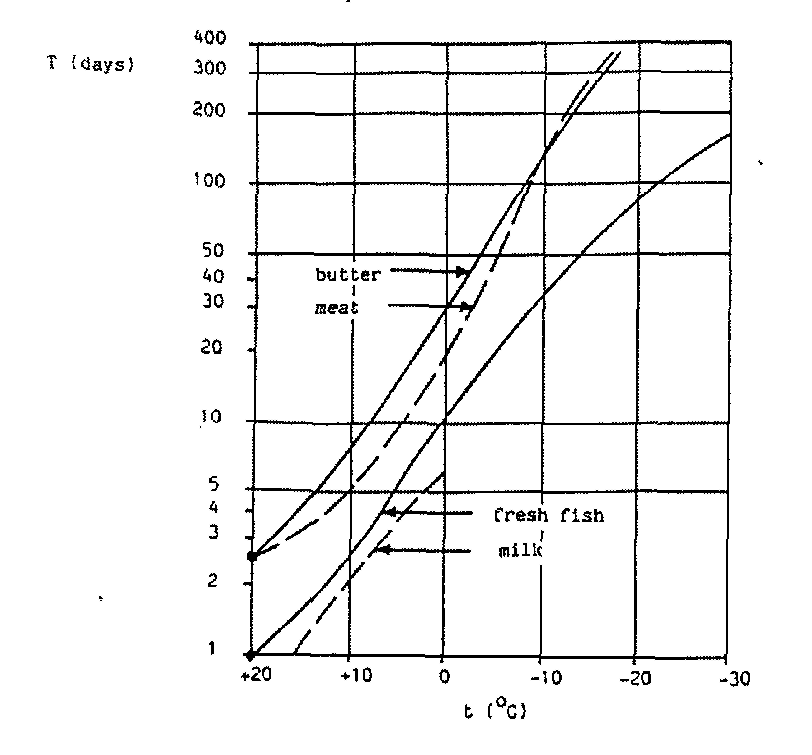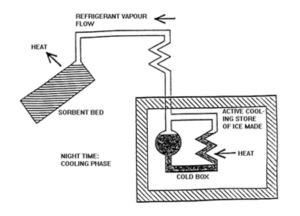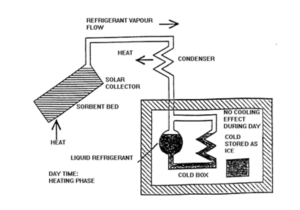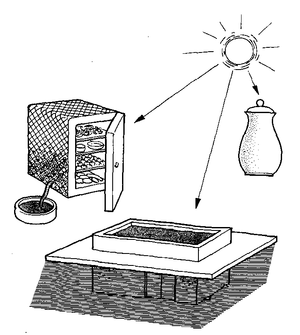
Refrigeration plays an important role in developing countries, primarily for the preservation of food, medicine, and for air conditioning. Examples of these applications are:
- In agriculture and dairies: removal of field heat immediately after harvesting of crops, storage of fruit, flowers, vegetables, milk, meat, and cooling during transport.
- In retail trades: sale of fresh foods, fish and cold drinks.
- Buildings, computer installations: air conditioning and temperature regulation.
- Domestic: food and drink storage.
- Health clinics: storage of blood, vaccines and medicine.
Choice of technology[edit | edit source]
Cooling can be provided in different ways. The method adopted in industrialized countries depends heavily on grid electricity, supplied continuously and reliably to every part of the country. In contrast, refrigeration is required in developing countries to stimulate agriculture and commerce, in vast areas without a reliable electricity supply. Alternative methods are therefore necessary. A number of approaches can be considered. Three kinds of cooling technology are contrasted in Figure 1 a-c, these are:

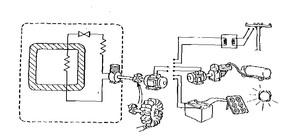
- Passive (Figure 1a)
- Sorption heat driven (Figure 1 b)
- Mechanical compression (Figure 1c)
- Magnetic cooling
- Thermoelectric cooling
- Others (ie Malone refrigeration, pulse tube refrigeration,...)[1]
The third method, mechanical compression, is usually dependent on a reliable and continuous supply of grid or diesel generated electricity. The other two methods are therefore more suitable in non-industrialized areas. They require further development on the basis of requests from users in rural locations. Several approaches, which can be considered, are:
- Production of ice using electricity in regional centres; transport of this ice to agricultural areas; packing of produce to be cooled with ice in insulated containers. Electricity is either grid or diesel generated. Refrigerators, which are electrically driven, use mechanical compression technology.
- In some cases refrigerators can be driven directly by mechanical shaft power, for instance where water turbines can be readily installed.
- Production of ice using heat driven coolers ('HDCs') on a local level at agricultural production points. Packing of produce with ice for transport. The heat sources for HDCs are varied; it can be from wood, charcoal or agro-waste burnt in open stoves, from fossil fuel in conventional burners, or it can be from thermal solar collectors. HDCs use sorption technology.
- Provision of cold storage chambers using either passive, sorption, or mechanical compression technology. If passive cooling is used, temperatures less than 10°C can rarely be achieved.
- Provision of cold storage at the point of use using mechanical compression coolers drawing electricity from photovoltaic cells. This is referred to as photovoltaic cooling technology.
The most suitable method of cooling chosen will depend upon various factors; the application, the degree of reliability required, the supply of power, the level of skill needed to operate and maintain, training facilities, and available finance. The different technologies should be considered with these factors in mind. As with any technology, sufficient training is especially important; it must be planned as an integral part of an implementation programme and remains a constant concern during the years following installation. This will increase reliability of the system and reduce life cycle costs dramatically.
Temperatures and ventilation[edit | edit source]
Different applications have different requirements for temperature control and ventilation. Figure 2 shows the temperatures needed for the storage of butter, meat, fresh fish and milk. Very often storage of vegetables is complicated by the need for careful ventilation to remove unwanted gases, and to avoid humidity conditions, which would spoil the produce. Relative humidity requirements vary depending on the moisture content of the produce. A simple method of increasing humidity is to sprinkle water on the floor. In vaccine and blood storage very careful temperature control is required.
Passive[edit | edit source]
In applications where temperatures between 10-25°C are needed, passive methods can be used. These include traditional methods such as the use of porous jars or wet sack coverings, where the evaporative heat of the liquid, usually water, is drawn into the atmosphere. This method is effective where the atmosphere is naturally dry. Domestic storage devices have been designed along these lines, particularly with the use of charcoal beds, drip-fed with water.
Nocturnal cooling in areas where clear night skies are common, can be effective. In airconditioning applications, the use of shade has been developed effectively in traditional architecture, together with evaporative cooling by fountains and roof ponds.
Wherever possible passive methods should be used both in agriculture and architecture, since they can be sustained locally and are economic. Only when cooling below 10°C is needed, is it justifiable to look at active cooling technology, requiring complex machinery, and technical maintenance programmes.
Sorption Heat driven coolers (HDCs)[edit | edit source]
The principle behind Sorption Heat driven coolers[2] is sorption refrigeration. The workings of sorption refrigeration is shown in Figure 3 which illustrates the simplest type of sorption cooler and which has an intermittent cycle consisting of two phases. Continuous cycles are also possible -the Electrolux uses a continuous cycle. The general term sorption covers both liquid absorption and solid adsorption variants of this technology. Sorption units have some very important advantages. They can be designed to contain no moving parts, so that skilled maintenance personnel and replacements of components are less likely to be needed. Secondly, they are simple to manufacture; local manufacture increases local knowledge of the technology, which improves operation, maintenance and faultfinding. Thirdly, they are readily adaptable to locally available fuels, including biomass and solar energy. Finally, the refrigeration circuit does not use CFCs, which damage the environment. Sorption units are referred to as HDCs (heat-driven coolers).
Conventional gas and kerosene-driven sorption units[edit | edit source]
The heat source in conventional sorption refrigerators is usually gas or kerosene flame. Units powered from gas bottles are used on caravans or boats. A domestic unit, often used in remote locations in developing countries is the kerosene-driven Electrolux. It has been calculated that the cost of purchasing and running one of these units is around £1000 for 10 years use. The refrigeration circuits of these devices operate reliably for many years. Maintenance of the burner assembly is required and a constant supply of wicks, burners and lamp glasses are essential. Lastly, the fuel tank must be replenished with kerosene of suitable quality. These units involve the use of hydrogen as a working fluid and cannot be designed as efficient ice makers, although they have some ice-making capacity.
Novel sorption units[edit | edit source]
Novel sorption units are being developed at present for greater efficiency in ice making and cold storage. They do not involve hydrogen as a working fluid. A great deal of emphasis is being placed on design for reliable operation in remote environments where technical maintenance services are not available. Emphasis is also placed, in some cases, on design for local manufacture.
Costs and performance figures are not easily available since many units are still on trial. Projected retail prices for biomass driven units are in the order of £2000 for a 100-kg per day icemaker. Taking fuel and operation costs into account, as well as capital repayment, this represents a production cost of ice of around £0.02 per kg.
Solar-powered sorption units[edit | edit source]
The heat source for sorption units of the kind shown in Figure 3 can be the sun. In a simple version the heating phase ends at sunset, and the refrigeration phase occurs during the night. If the sun fails to shine for a few days, the ice made on previous days acts as a cold store, keeping the cold box at a low temperature while it gradually melts. It is expected that a unit producing 100 kg of ice per day can be produced for £4,000 (including the cost of highly efficient solar thermal panels), giving an ice cost of £0.03 per kg.
Mechanical Compression[edit | edit source]
Grid electricity[edit | edit source]
Where a reliable electricity supply exists, the most economic option is to install a standard compressor driven unit. Conventional refrigerators of this kind are sold commercially. As an example, a unit making about 100 kg of flaked ice, for fisheries use, each day in tropical conditions will cost £7000, not including the cost of storage containers for the ice, or delivery. The power consumption would be in the order of 4 kW continuously. There will be extra costs in the form of replacement parts, maintenance and ancillary equipment.
Water turbine driven coolers[edit | edit source]
Costs can be reduced if shaft power is used directly to drive the compressor, for example from a water turbine. An auxiliary electricity supply is useful to provide control and protection functions, and for instance to drive ventilation fans. It is nevertheless feasible to design wholly mechanical cold storage and ice-making systems.
Diesel generating sets[edit | edit source]
The cost of operating a generator in rural areas is dependent on local conditions and must be assessed in the light of local experience. Quite often the cost can be very much higher than expected because of the need for maintenance personnel and the difficulties encountered in obtaining fuel and spare parts. If the generated electricity is not available continuously then the refrigerator should be designed as an ice-maker, allowing cold to be stored in the form of ice. Experience has shown that systems involving the storage of electricity in batteries have very high costs and are unreliable.
Solar photovoltaic systems[edit | edit source]
Solar energy is an intermittent power source, usually available for 12 hours every day. The intensity of insolation is very variable. It can be converted by photovoltaic cells into electricity, which is then stored in batteries, so that a continuous smooth electrical supply can be provided to power a mechanical compression refrigerator.
The advantage of using solar power is that it is a source that can be relied upon, never to fail for more than a few days. This reliability is very important in some cases, such as vaccine storage, where loss of temperature control can spoil the vaccines completely. The battery is designed to continue to provide electricity at night and on days when no sunshine is available. In this application, the high cost of photovoltaic cells, batteries and control equipment is justified. The size of the photovoltaic array and the battery capacity must be carefully calculated to provide an economic system.
Solar refrigeration units of this kind, especially designed for vaccine preservation, are commercially available. A system providing 60-80 watts of cooling is typically priced in the range of £3000-5500. Replacement parts will tend to cost £500-1000 in the course of four years of operation. Most of this cost will be in the replacement of batteries which are designed to have a four year life but can fail in a shorter period if maintained poorly. Replacement costs are considerably reduced if skilled, technical maintenance personnel are available.
Combined heating/drying/cooling system[edit | edit source]
Because a refrigerator releases heat it can be used to raise temperatures in agricultural processes like crop or spice drying. The cooling effect can be used to dehumidify the air passing over the crop and the heating effect can be used to warm the air. In this, very high efficiencies can be obtained (for instance up to 7 times as much useful energy produced as required to drive the device). Such efficiencies are commonly met in timber drying plants using these principles. Practical Action is developing low cost methods of utilizing this effect, with respect to drives from small hydro turbines or from steam or diesel engines.
A second example is the use of heat from a refrigerator (also known as a heat pump, exactly the same machine) to help sterilize milk, while the same refrigerator cools the milk to preserve it.
Others[edit | edit source]
Refrigerators and air conditioners operating from the waste heat of a diesel engine exhaust, heater flue or solar collector are also entering use. These use the same principles as a gas refrigerator. Normally, the heat from a flue powers an "absorptive chiller". The cold water or brine from the chiller is used to cool air or a refrigerated space.
Cogeneration is popular in new commercial buildings. In current cogeneration systems small gas turbines or stirling engines powered from natural gas produce electricity and their exhaust drives an absorptive chiller.
A truck trailer refrigerator operating from the waste heat of a tractor's diesel exhaust was demonstrated by NRG Solutions, Inc. NRG developed a hydronic ammonia gas heat exchanger and vaporizer, the two essential new, not commercially available components of a waste heat driven refrigerator.
Fans can be useful to cool a room.
A similar scheme (multiphase cooling) can be by a multistage evaporative cooler. The air is passed through a spray of salt solution to dehumidify it, then through a spray of water solution to cool it, then another salt solution to dehumidify it again. The brine has to be regenerated, and that can be done economically with a low temperature solar still. Multiphase evaporative coolers can lower the air's temperature by 50°F, and still control humidity. If the brine regenerator uses high heat, they also partially sterilise the air.
Choosing the system[edit | edit source]
In order to decide which refrigeration system to adopt for a particular purpose, it is necessary to consider the ongoing inputs required by each system. Table 1 lists the various systems and the inputs required for each. The choice of system is based on the foreknowledge that all the necessary inputs will continue to be available in the locality of the fridge. The mistake is often made of installing a unit with a relatively low purchase cost which later ceases to function through lack of necessary inputs.
| COMMENT | ENERGY SOURCE | PERSONNEL | SPARE PARTS | 10 YEAR TOTAL COST | |
| MECHANICAL
COMPRESSION |
|||||
| Grid | Electricity
available for other purposes, e.g. lighting, flaking of ice. |
Grid electricity.
Cost of connecting/ transforming can be high. |
Maintenance:
skilled personnel. |
Source of parts may be distant.
Supply may be uncertain. |
Purchase
cost, electricity, personnel, replacement parts. |
| Diesel | Electricity
available for other purposes, e.g. lighting, flaking of ice. |
Diesel generator | Maintenance:
skilled personnel permanently on-site. |
Source of
parts may be distant. Supply may be uncertain. |
Purchase
cost, diesel, replacement parts. |
| Solar photovoltaic | Expensive.
Electricity available for lighting, communications, temperature control. |
Irradiation of 10-20MJ/daym2. Long
cloudy periods problematic. |
Skilled
personnel permanently available. |
Battery life 2-4 years.
Control electronics can fail. |
£3500-6500
for 60-80W cooling, includes replacement costs. |
| SORPTION
(HDCs) |
|||||
| Conventional | Well known in the field. | Gas/kerosene
quality must be adequate. |
Burner parts,
wick adjustment, etc. |
Replacement
of burner parts routine. |
£1000-2000
for 60-100W cooling and small maintenance cost. |
| Novel (bio mass
driven) |
Local
manufacture possible. Under development, relatively low cost. |
Any locally
available heat source suitable, e.g. charcoal, coal, agro wastes, cow dung fossil fuels. |
Maintenance of
open burner, brine tank, cooling water. Local skills sufficient. |
Locally
available spare parts. |
Purchase
cost projected at £2000 for 100kg ice/day. Fuel cost £50-100 per year. |
| Solar | Very new on market.
Performance not yet evaluated. Low night temperatures can be advantageous in some cases. Presence of cooling water advantageous. Provincial manufacture possible. |
Solar irradiation 10-120MJ/daym2.
Long periods of cloud problematic. |
Local skills
sufficient, few moving parts. |
Solar panels
may require import of spare parts. |
Current
purchase cost £1500-2500 for 10kg ice/day. Projected cost £4000 for 100kg ice/day (including solar panel). |
Further information[edit | edit source]
Further information on refrigeration in developing countries is available from:
Literature[edit | edit source]
ASHRAE Handbooks:
- 1997 - Fundamentals
- 1998 - Refrigeration
- 1999 - HVAC Applications
- 2000 - HVAC Systems and Equipment
American Society of Heating, Refrigeration & Air Conditioning Engineers (ASHRAE)
1791 Tullie Circle
North East Atlanta
GA 30329,USA
Tel: +1 (404) 636-8400
Fax:+1 (404)321-5478
Website: www.ashrae.org
P D Dunn: Energy for Developing Countries.
R J Dossat: Principles of Refrigeration. Prentice Hall, 1997, 4th ed.
RayTomkins: Prospects for Solar Refrigeration, 1985
Ray Tomkins Management School
Imperial College, 53 Princes Gate
Exhibition Road, London, SW7 2PG, U.K.
Tel:+44 (0)20 7594 9137
Fax: +44 (0)20 7823 7685
Website: www.ms.ic.ac.uk
B. McNelis, A. Derrick & M. Starr: Solar Powered Electricity: A survey of Photovoltaic Power in Developing Countries. ITDG Publishing, 1988.
Solar Power for Development UK ISES Conference Proceedings 1988
Organizations[edit | edit source]
Institute of Food Research,
Norwich Research Park, Colney,
Norwich NR4 7UA, U.K.
Tel+44 (0)1603 255 000
Fax+44 (0)1603 507 723
Rebecca Sweet, Information Services Manager and Chief Librarian -rebecca.sweet@bbsrc.ac.uk
Diana Green, Library Assistant -diana.green@bbsrc.ac.uk
General/ILL - ifr.library@bbsrc.ac.uk
Website: www.ifrn.bbsrc.ac.uk
EPI (Expanded Programme on Immunisation),
World Health Organisation
,
Attn Director EPI,
Avenue Appia 20, 1211 Geneva 27,
Switzerland.
Tel:+41 (0)22 791 4517
Fax:+41 (0)22 791 4193
WHO Website Addresses:
Home Page: www.who.int,
Solar Energy and Rural Health Care: Fact Sheet N132:
www.who.int/inf-fs/en/fact132.html,
Solar Energy Applications (with links to product information sheet):
http://www.who.int/vaccines-access/Vaccines/Vaccine Cold Chain/solarenergy.htm
Health Link Worldwide,
Cityside House, 40 Adler Street,
London E1 1EE, U.K.
Tel:+44 (0)20 7539 1570
Fax:+44 (0)20 7539 1580
Website: www.healthlink.org.uk
International Institute of Refrigeration,
177 Boulevard Malesherbes,
75017 Paris, France.
Tel: +33 (0)1 4227 3235,
Fax:+33 (0)1 4763 1798,
Website: www.iifiir.org
Institute of Refrigeration,
Kelvin House, 76 Mill Lane,
Carshalton, Surrey, SM5 2JR, U.K.,
Tel: +44 (0)20 8647 7033,
Fax:+44 (0)20 8773 0165,
Website: www.ior.org.uk
NR International
Park House
Bradbourne Lane
Aylesford, Kent, ME20 6SN
Tel:+44 (0)1732 878 686/7
Fax:+44 (0)1732 220 498
E-mail: info@nrint.co.uk
Website: www.nrinternational.co.uk
Manufacturers[edit | edit source]
Note: This is a selective list of suppliers and does not imply endorsement by Practical Action.
Ice making machines[edit | edit source]
Total Refrigeration Ltd.,
Dunkirk Lane, Hyde,
Cheshire SK14 4PW, U.K.
Tel:+44 (0)161 366 2535
Fax:+44 (0)161 366 0342
E-mail: total@totalrefrigeration.co.uk,
Website: www.totalrefrigeration.co.uk,
Icemakers, cabinets, chiller & freezer cold rooms.
Ziegra Ice Machines (UK) Ltd.,
Unit 14, Enterprise Centre 2,
Chestergate, Stockport, Cheshire, SK3 0BR, U.K.
Tel:+44 (0)161 429 0525
Fax:+44 (0)161 480 7927
Website: www.ziegra.co.uk
Specialists in ice machines and ice storage systems.
Trembath Refrigeration and Air Conditioning Ltd.,
Felstead Road, Longmead Industrial Estate,
Epsom, Surrey, KT19 9XS, U.K.
Tel:+44 (0)1372 215010
Fax:+44 (0)1372 215011
Ice-makers, refrigeration, air conditioning,
dehumidifiers, heat pumps, design,
manufacture, installation and maintenance.
Sorption machines[edit | edit source]
Electrolux Leisure Appliances AB
SE-105 45 Stockholm
Sweden
Tel: +46 (8) 738 64 26
Fax: +46 (8) 738 75 38
Website: www.electrolux.com/worldfridge
Sibir International AB
S-105 45 Stockholm
Tel:+46 (8) 738 61 18
Fax: +46 (8) 738 75 38
Website: www.sibir.com
See also[edit | edit source]
- Category:Refrigeration
- Heat pump system: can also cool when run in reverse
External links[edit | edit source]
- Some other useful designs: Peltier coolers, pot-in-pot refridgerators
- Design for a refridgerated storage room
